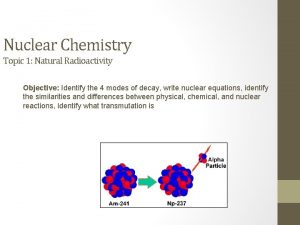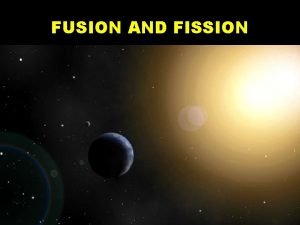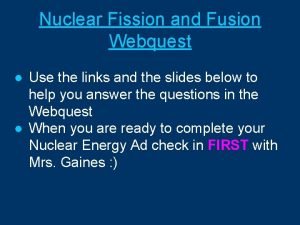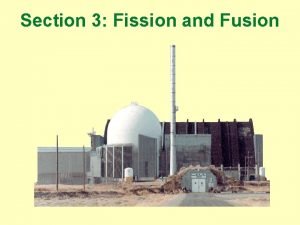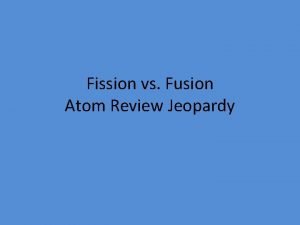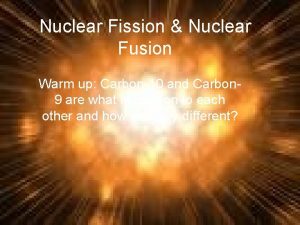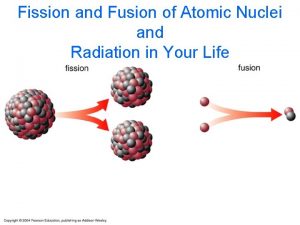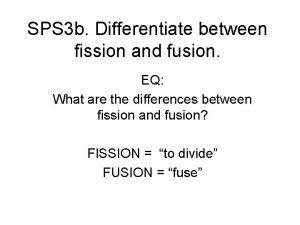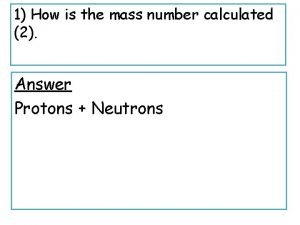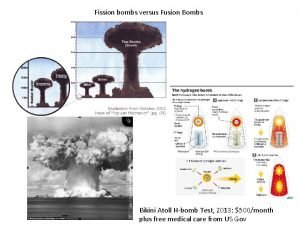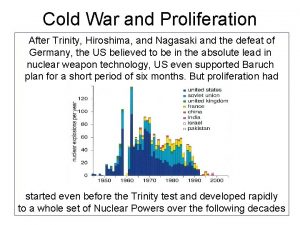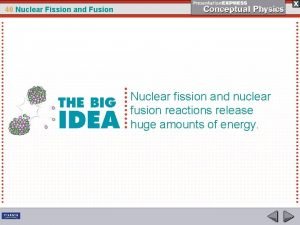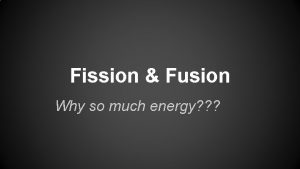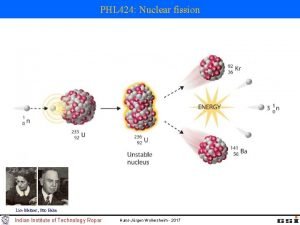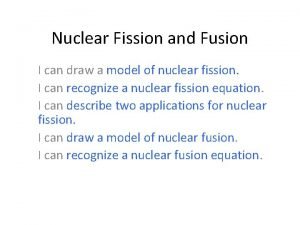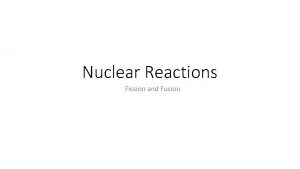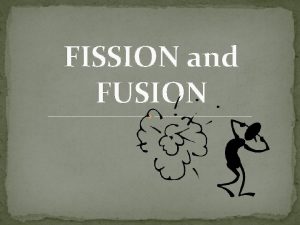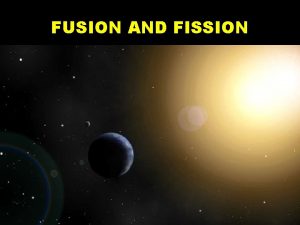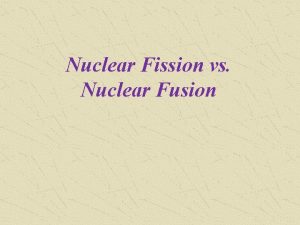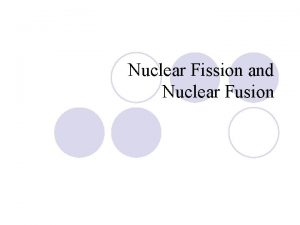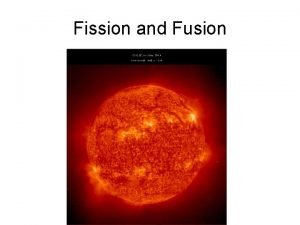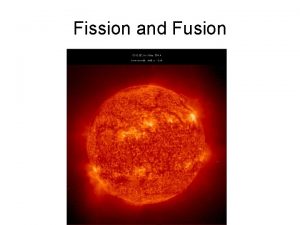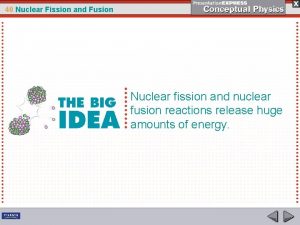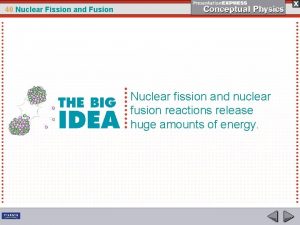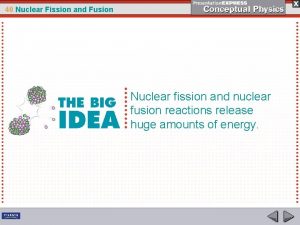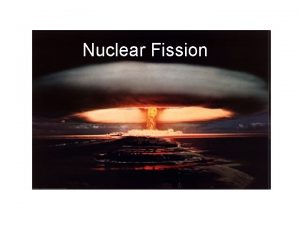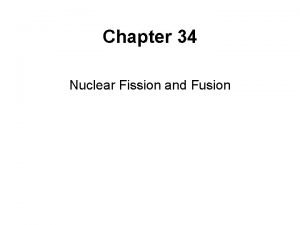FISSION and FUSION Nuclear Fission The splitting of















- Slides: 15

FISSION and FUSION

Nuclear Fission �The splitting of a more massive nucleus of an atom into 2 smaller nuclei, subatomic particles and energy (radiation)

Nuclear Fission 3

Fission Reaction: 235 1 n+ U 0 92 92 141 1 Kr + Ba + 3 n + energy 0 36 56 92 ___ 141 1 Kr ____ + Ba + 3 n + energy 0 56 36 ___

Nuclear Fission at Work – CANDU Reactors (Canadian Nuclear Reactors) • Currently about 103 nuclear power plants in the U. S. and about 435 worldwide. • 17% of the world’s energy comes from nuclear.

Fission Chain Reaction

Figure 19. 6: Diagram of a nuclear power plant.

� CANDU Reactors and Hazardous Wastes Hazardous wastes produced by nuclear reactions are problematic. � Most of this waste is buried underground or stored in concrete. � It will take 20 half-lives (thousands of years) before the material is safe. See pages 319 - 320

Fission Chain Reaction at work • A fission bomb uses an uncontrolled nuclear fission chain reaction to release an enormous amount of energy in a small amount of time. • Fission bomb (atomic bomb) is the original one exploded over Japan. Nuclear Bomb Test (actual footage from 1946) http: //www. youtube. com/watch? v=Z 29 H_AX-j. Ts Atomic Bomb Test http: //www. youtube. com/watch? v=s. KEt. Icyx 4 KM http: //www. youtube. com/watch? v=NNc. QX 033 V_M

Properties Fission sounds like= DIVISION Memory Clue What Splitting ONE nucleus into TWO smaller nuclei, subatomic particles and radiation. (Energy) Where In nuclear reactors and in the atomic bomb. Why Source of massive amounts of energy How We split the nucleus by bombarding or shooting it with various particles to cause the already unstable, heavy nucleus to split apart. Products Radioactive

Nuclear Fusion �The joining (fusing) of 2 smaller, lower mass nuclei together, to make 1 more massive nucleus, and give off energy and subatomic particles too.

12 Nuclear Fusion small nuclei combine 2 H 1 + 3 H 4 He 1 2 Occurs in the sun + 1 n + 0 Energy

Fusion Reaction: 2 3 H 1 H+ 1 1 3 n+ 0 92 Kr 36 4 2 141 + He + Ba 56 1 n + energy 0 235 1 U + 0 n + energy 92

Fusion chain reaction at work • thermonuclear weapons (aka hydrogen bombs) • Fusion bombs have two main stages. These are called the "primary" and the "secondary". The primary reaction is a regular fission chain reaction. The radiation from this reaction is used to heat the interior of the bomb to temperatures where a fusion reaction can be sustained. Also, the neutrons produced from the fission reactions are used in the secondary (fusion) part of the reaction. The secondary is composed of lithium-deteuride (deuteride is basically deuterium, which is 2 H). The lithium deteuride, under intense heat, splits apart into lithium (6 Li) and deuterium ions. The neutrons produced from the primary (fission) reaction react with the 6 Li to produce 4 He and 3 H. This reaction can be expressed in the following equation: 1 neutron + 6 Li 4 He + 3 H 3 H + 2 H 4 He + 1 neutron • A thermonuclear fusion bomb is generally a lot more powerful than a fission bomb. Interestingly, the harmful fall-out from a fusion bomb is generated mostly from the products of the primary (fission) reaction. These are the fission products and the transuranic products, just like in the fallout of a standard fission bomb.

Properties Memory Clue What Where Fusion= To fuse= comes together The joining (fusing) of TWO smaller, lighter nuclei to make ONE larger, heavier nucleus with the release of subatomic particles and radiation (Energy) In core of the sun (natural) and in the H (hydrogen) bomb Why Source of massive amounts of Energy How Nuclei can only fuse under tremendous temperature and pressure, Achieve this in a hydrogen bomb first by creating a fission reaction. Products Not Radioactive
 Artificial transmutation worksheet
Artificial transmutation worksheet Fission and fusion similarities
Fission and fusion similarities Is the sun fusion or fission
Is the sun fusion or fission Nuclear fission and fusion webquest answer key
Nuclear fission and fusion webquest answer key What is fission and fusion
What is fission and fusion Fussion vs fission
Fussion vs fission Are nuclear power plants fission or fusion
Are nuclear power plants fission or fusion Fission vs fusion nuclear
Fission vs fusion nuclear Compare and contrast fission and fusion.
Compare and contrast fission and fusion. Fission and fusion similarities
Fission and fusion similarities Fission vs fusion
Fission vs fusion Rds 37
Rds 37 Fission vs fusion
Fission vs fusion Fusion or fission
Fusion or fission Nuclear fission lise meitner
Nuclear fission lise meitner Nuclear fission equation
Nuclear fission equation

